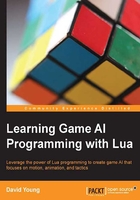
What this book covers
Chapter 1, Getting Started with AI Sandbox, begins with learning the overview of how projects are set up as well as how the Lua script interacts with C++ code. Here, the beginnings of the AI sandbox are built from open source technologies, starting with a framework that integrates Lua, Ogre3D, OpenSteer, and Bullet Physics.
Chapter 2, Creating and Moving Agents, starts off with examples of the lowest layer of AI interaction with the world, local steering, and movement. Here, agent seeking, avoiding, and group movement are introduced into the sandbox through the use of the OpenSteer library.
Chapter 3, Character Animations, continues with the AI sandbox by exposing Ogre3D's animation playback and resource handling of Lua scripts. Low-level structures for controlling animation clips, animation state machines, and layered animations are integrated into the sandbox.
Chapter 4, Mind Body Control, combines animation handling with local steering and agent movement. Two different approaches toward mind and body interactions will be implemented. The first will focus on the latency between agent decisions and actions, while the second approach will focus on the perceived quality of the agent's actions.
Chapter 5, Navigation, builds up from local movement and moves on to long distance movement and planning. Navigation mesh generation provided by the Recast library will be integrated into the AI sandbox in order to allow A* pathfinding provided by the Detour library.
Chapter 6, Decision Making, adds intelligence to the choices the AI agents make. Different data structures and approaches to creating modular and reusable decision logic are covered through Lua scripts. Decision trees, finite state machines, and behavior trees are integrated into the sandbox.
Chapter 7, Knowledge Representation, adds the ability to store long-term and short-term information for individual agents. A centralized approach to storing and propagating agent knowledge about the world is exposed to Lua.
Chapter 8, Perception, exposes the services that are available to agents for them to query information about the world. Approaches toward visual- and communication-based information is integrated into the sandbox.
Chapter 9, Tactics, exposes a high-level spatial knowledge of the environment to the sandbox. Through a grid-based representation of the world, different knowledge sources are combined in order to give you an accurate tactical view of the environment for decision making.